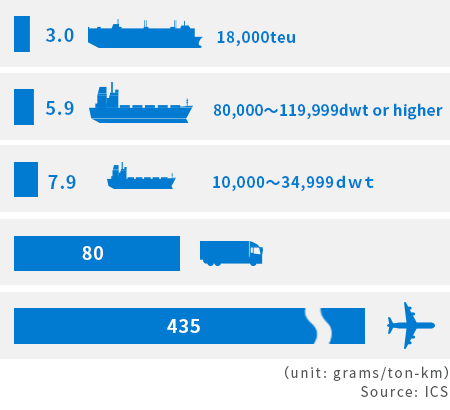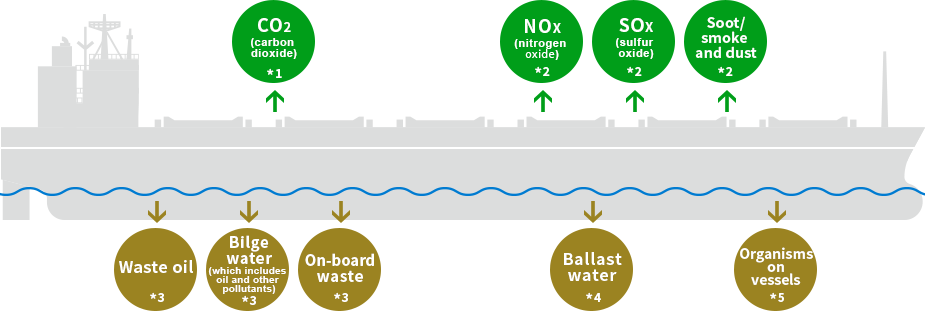- JP
- EN
Regulations
Ocean Shipping's Impact on the Environment

(Unit: grams/ton-km)
Compared to other modes of transport, ocean shipping can transport larger volumes of cargo at once and is a generally environment-friendly mode, with lower emissions per unit load of CO2 and other air pollutants.
However, with growth of the world economy spurred by the development of emerging markets, overall world ocean cargo traffic continues to increase. Seaborne trade has exceeded 10 billion tons, and we anticipate further increases in the future. As seaborne trade increases, CO2 emissions will rise in step with growing energy consumption. This can exacerbate pressing environmental issues such as increase of typhoon which may cause the port delay or suspension of ferry service. CO2 emissions from merchant vessels account for about 2% of global emissions, and the shipping industry must do more to protect the environment. MOL strives to control emissions of pollutants through initiatives such as the adoption of advanced technologies and slow steaming.
In April 2022, we unveiled "One mile ahead" as our new technology slogan with the aim of enhancing technological evolution and encompassing not only "vessels," but also, in a broader sense, "the sea." To view our Organizational Structure to Promote Technological Innovation, please click here.
In 2022, our dedicated efficiency operation team at the headquarters, we established a new company in the Philippines, EcoMOL (Currently MOL Enterprise (Philippines) Inc.), to promote efficient operations (the DarWIN project). The DarWIN project pursues efficient vessel operation based on three pillars: system, organization, and process, and introduces energy-saving equipment in partnership with Akishima Laboratories (Mitsui Zosen Inc.) and MOL Techno-Trade, Ltd. Through these efforts, we are working to improve fuel efficiency and reduce GHG emissions.
- Atmospheric Impact
-
CO2 emissions (global warming)
- Fuel consumption reductions(DarWIN Project)
- Technology development(ONE MILE AHEAD)
Link: MOL Group Environmental Vision 2.2, Organizational Structure to Promote Technological Innovation
NOx emissions / SOx emissions (atmospheric pollution)
- Fuel consumption reduction*2
- Technology development(NOx-reducing SCR, SOx scrubber, DPF*, etc.)*2
* PM (particulate matter) reduction system
Link: NOx Emission Countermeasures, SOx Emission Countermeasures, Soot/Smoke and Dust Countermeasures

- Ocean Impact
-
Oil pollution / On-board waste (Ocean pollution)
- Proper treatment*3
Link: Approaches to Marine Environmental Protection
Ballast water / Organisms on vessels (Biodiversity)
- Technology development(ballast water treatment system*4 / paint*5, etc.)
Refer to this environmental data compilation for information on MOL CO2 emissions.
Various environmental regulation
Ship-related issues should not be addressed by a single nation, but on an international basis because vessels move all over the world. The United Nations Framework Convention on Climate Change directs the International Maritime Organization (IMO) to study measures to reduce GHG emissions in international ocean shipping. Currently, the IMO studies, adopts, and issues various international conventions and regulations.
MOL Group is committed to reducing its environmental impact while preserving the global environment through company-wide efforts to respond to a variety of environmental regulations.
| ~2021 | 2022 | 2023 | 2024 | 2025 | 2026 | 2027 | 2028 | 2029 | 2030 | |||
|---|---|---|---|---|---|---|---|---|---|---|---|---|
| Climate change countermeasures | EEDI [MARPOL AnnexⅥ] |
Phase 2 | Phase 3 | |||||||||
| EEXI [MARPOL AnnexⅥ] |
Adoption | |||||||||||
| CII [MARPOL AnnexⅥ] |
Adoption | |||||||||||
| SEEMP [MARPOL AnnexⅥ] |
Mandatory | |||||||||||
| DCS [MARPOL AnnexⅥ] |
Mandatory | |||||||||||
| EU-MRV [Regulation (EU) 2015/757] |
Mandatory | |||||||||||
| EU-ETS [Directive (EU) 2023/959] |
Adoption | |||||||||||
| FuelEU Maritime [Regulation (EU) 2023/1805] |
Adoption | |||||||||||
| Prevention of Air Pollution | SOx(sulfur oxides) PM (particulate matter) [MARPOL AnnexⅥ] |
General sea area | Sulfur content limit 0.5% | |||||||||
| ECA | Sulfur content limit 0.1% | |||||||||||
| NOx(nitrogen oxides) [MARPOL AnnexⅥ] |
General sea area | Tier Ⅱ regulation | ||||||||||
| ECA | Tier Ⅲ regulation | |||||||||||
| Preservation of marine environments and Protection of biodiversity | Prevention of Pollution by Oil,Noxious Liquid Substances, and Harmful Substances [MARPOL AnnexⅠ, Ⅱ, Ⅲ] |
Mandatory | ||||||||||
| Sewage from Ships [MARPOL AnnexⅣ] |
Mandatory | |||||||||||
| Garbage from Ships [MARPOL AnnexⅤ] |
Mandatory | |||||||||||
| Ballast Water [Ballast Water Management Convention] |
Mandatory | |||||||||||
| Biofouling [Biofouling Guidelines] |
Guidelines adopted in 2011 | |||||||||||
| Prohibition of use of designated harmful substances in Anti-fouling systems [AFS Convention] |
Mandatory | |||||||||||
| Underwater noise | Discussing the impact by ships | |||||||||||
| Ship Recycling [Ship Recycling Convention] |
Adopted in 2009. | Mandatory | ||||||||||
- MARPOL
- International Convention for the Prevention of Pollution from Ships. It is the main international convention covering prevention of pollution of the marine environment by ships from operational or accidental causes. It includes 6 annexes.
Climate change countermeasures
- EEDI
- Energy Efficiency Design Index. Adopted by IMO in 2011. For vessels delivered after July 2015 (*), the standard energy efficiency level (the amount of CO2 emiss ion per ton-mile) is set for each vessel. It started in 2013, and the energy efficiency level is tightened incrementally. The reduction rate targets for each phase are Phase 0 = 0%, Phase 1 = 10%, Phase 2 = 20%, Phase 3 = 30-50%.
(*)
a vessels
- for which the building contract is placed on or after 1 January 2013;
- in the absence of a building contract, the keel of which is laid or which is at a similar stage of construction on or after 1 July 2013;
- the delivery of which is on or after 1 July 2015. - EEXI
- Energy Efficiency Existing Ship Index. Similar to the EEDI regulation for new vessels, it requires to improve energy efficiency for existing vessels. It was adopted by IMO in 2021 and will be applied from 2023. A standard energy efficiency is set for each vessel. For vessels that do not meet the standard level, measures to improve fuel efficiency such as engine output restrictions and additional energy-saving devices are required.
- CII
- Carbon Intensity Indicator. As with the EEXI regulation, it was adopted by IMO in 2021 and will be applied from 2023. Annual energy efficiency value is calculated annually from the operation results of individual vessels, and the rating of each vessel is evaluated in five stages from A to E.
- SEEMP
- Ship Energy Efficiency Management Plan. Adopted by IMO in 2012.From 2013, selection of an operational method for each vessel to improve energy efficiency, documentation of the action plan, and adoption of method aboard the vessel are required. SEEMP targets both newbuilding vessels and existing vessels.
- DCS
- Data Collection System. Adopted by IMO in 2016.The system is intended to report fuel consumption data from ships and transport work to the IMO, introduced in 2019.It is used as a data source for IMO GHG emissions reduction strategies, such as CII evaluation and introduction of Market Based Measures. The expansion of data collection scope is being considered in IMO.
- EU-MRV
- EU-Monitoring, Reporting, and Verification of carbon dioxide emissions. Aopted by the European Parliament in 2015 and introduced in 2018. It is applied for the vessels with gross tonnage exceeding 5,000 tons calling at ports under the jurisdiction of EU member states. It obliges preparation and certification of monitoring plans and emission reports for collecting and reporting data on fuel consumption, transport work, cargo volume, etc.
- EU-ETS
- The EU-ETS (European Union Emission Trading System) is a GHG emission trading system introduced in the European region since 2005, and its application to the maritime sector began in January 2024. The cap-and-trade system is adopted, and ships calling ports within the jurisdiction of EU member states are required to purchase emission allowances (EUAs) in proportion to their GHG emissions and submit them to the country designated by the EU authorities. Failure to submit allowances by the deadline will result in penalties such as fines and a ban on sailing to EU ports.
- FuelEU maritime
- Regulations to be introduced in EU/EEA Member States from 2025 to promote the decarbonization of fuels used on board ships. It consists of three provisions: a provision setting a GHG intensity limit for fuels used on board ships; a provision requiring the use of shore-based power sources or zero-emission technologies while moored in port (for container and passenger ships only); and a provision for the use of renewable fuels of non-biological origin (REFNBO).
Prevention of Air Pollution
- SOx and PM emissions Regulations
- Sulfur content in fuel oil is controlled to reduce SOx and PM in exhaust emissions.Sulfur limits has been gradually tightened. The sulfur limit is 0.1% in the emission in the Emission Control Areas(ECAs(*)) from 2015, and 0.5% in tgeneral sea area from 2020. It is required to take measures such as using fuel oil that complies with regulations (compliant fuel oill), introducing SOx scrubbers, and switching to alternative fuels.
- NOx emissions Regulations
- NOx in exhaust gas from engines is controlled in a step-by-step manner. Tier I regulates emission levels by rated engine rpm, targeting vessels built between 2000 and 2010. Tier II requires vessels built in 2011 or later to reduce a further 15.5-21.8% from the Tier I level. In the ECAs(*), Tier III applies to vessels built in 2016 or later, requiring reduction of 80% from the Tier I level.
(*) ECA-designated sea areas:
(1) North America Coast – within 200 nautical miles (SOx/NOx), (2) United States Caribbean Sea (SOx/NOx), and (3) Baltic Sea and North Sea (currently SOx only. SOx/NOx in 2021 and later.)
Regulations to Protect the Marine Environment
- Ballast Water
Management Convention - It aims to prevent cross-border transfer of foreign marine organisms through ballast water of vessels. It was adopted in 2004 and is slated to go into effect in September 2017. Vessels are mandated to install a ballast water treatment system by the stipulated deadline, within seven years from the effective date at the longest.
- Biofouling Guidelines
- The transfer of invasive aquatic species by ships has been identified as a major threat to biodiversity. The Guidelines for the control and management of biofouling on ships to minimize the transfer of invasive aquatic species were adopted by the IMO in 2011 and revised in July 2023.
- AFS Convention
- Prohibits the use of products containing organotin compounds in ship bottom antifouling paints used to prevent marine organisms from adhering to hulls in order to protect the marine environment and human health. Adopted by IMO in 2001.
- Ship Recycling Convention
- It aims to prevent workplace accidents and environmental pollution in ship recycling. It was adopted in 2009, and will enter into force 24 months after the requirements are satisfied (scheduled to take effect in June 2025). It sets standards for ship recycling facilities and recycling procedures, and requires ships to create, maintain and update an inventory list of onboard hazardous substances.
